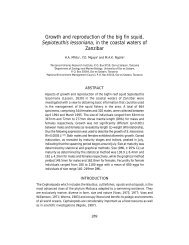gpa_east_africa_case.. - GRID Africa GeoPortal - UNEP
gpa_east_africa_case.. - GRID Africa GeoPortal - UNEP
gpa_east_africa_case.. - GRID Africa GeoPortal - UNEP
Create successful ePaper yourself
Turn your PDF publications into a flip-book with our unique Google optimized e-Paper software.
Oceanography. The oceanographic data shows clear alternate phenomena depending onthe prevailing wind direction: during the trade wind period the currents veer counter clockwisein the bay, while it reverses in a clockwise direction during the Northwest monsoon. Thecurrent speed is in any <strong>case</strong> extremely week, making the bay a confined area. As the bay issheltered from strong South<strong>east</strong> swells, there is a net surplus input of fresh water from theland (SETOI, 1990).Geology and Soils. Low-lying areas of Beau Vallon are the coastal plain area and low-lyingareas around the main river mouths. The sediments of the former are dominantly calcareouswhilst the latter are characterised by sediments consisting of fine clays and quartz derivedfrom laterites. The coastal shorelands of Beau Vallon consist entirely of calcareous sands.The soil types in the mountainous areas behind the coastal plain comprise laterite andkaolinitc clays forming red earth giving a base of dense vegetation.Beach Characteristics. The sandy beach of Beau Vallon is approximately 1.8 kilometreslong with an average width of 30 metres at low tide. Sand dunes exist only in a few smallareas protected by beach debris and by Takamaka trees. The sand is yellowish-white incolour and fine to medium. The Beau Vallon Beach is the most built-up beach in Seychellesand sea walls and buildings on the high water mark are evident. The beach is very active andseasonal movement of sand takes place. However, there is definite evidence of beacherosion characteristic of such highly disturbed sandy coasts (Shah, 1998).Ecology. The ecological characteristics of the Beau Vallon coastal zone are numerous bothspatially and in biodiversity, which include brackish water marshes, coastal vegetation, coralreefs and other marine fauna and flora (Payet, 1995). There are eight areas that can beconsidered as special ecosystems:Area In m 2 DescriptionNorthern Fringing Reef 700,000 Coral ReefSouthern Fringing Reef 260,000 Coral ReefNorthern Fringing Reef Flat 250,000 Inter-tidal and Littoral EcosystemSouthern Fringing Reef Flat 62,500 Inter-tidal and Littoral EcosystemMare Anglaise River Estuary 5,500 Ecosystems of Estuaries and Enclosed SeasSullivan River Estuary 3,900 Ecosystems of Estuaries and Enclosed SeasMare Anglaise River Wetlands 46,800 River and Stream EcosystemsSullivan River Wetlands 15,600 River and Stream EcosystemsSource: Grandcourt, 1995In the marsh areas, various species of mangroves are predominant with a host of crab andbird species. The amount of dissolved oxygen is usually very poor, ranging from 2 to 4 mg/l.This often allows for the propagation of anaerobic conditions within the marsh area. Thesemarshes act as buffer zones to reduce fresh water intrusions on the coral beds and provide azone of stabilisation and degradation of organic matter (Payet, 1995).Population. The area of Beau Vallon has a population of some 7,000, or 9% of the totalSeychelles population. The annual population growth rate is estimated at 2%, the number ofinhabitants per dwelling is 4.5 and urban development density is at 10–15 dwellings perhectare. Plans for the sub-division of land are already under way, and new development ofapartment buildings in the next five years will increase population and land use conflicts. Atotal of 512 additional units will be completed in the study area in the next years,corresponding to a net population increase of some 1,152 inhabitants.Population Projections for greater Beau VallonYear 1995 2002 2010Population 6,501 7,617 8,924Source: SOGREAH, 1996Tourism. Tourism is the mainstay of the Seychelles economy and it is likely to remain so inthe near future. The sector accounts for approximately 18% of GDP, employs one fifth of theFinal Draft Report – Cost Benefit Case StudiesGPA Strategic Action Plan on Sewage, October, 200089



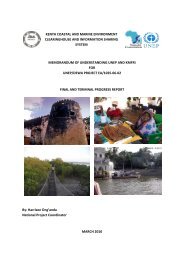
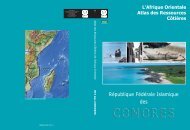
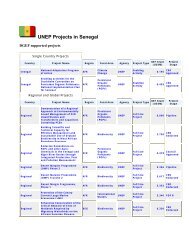

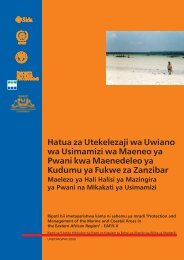
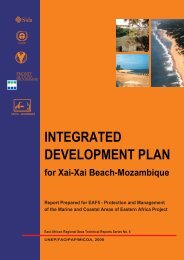
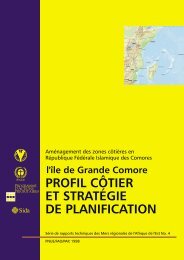
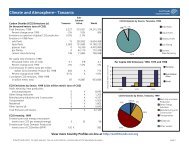

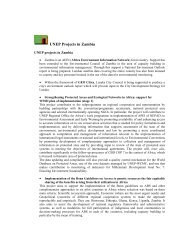
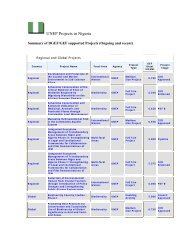
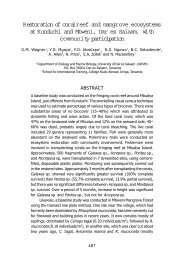
![Please Click to download [English] - GRID Africa GeoPortal - UNEP](https://img.yumpu.com/30633391/1/184x260/please-click-to-download-english-grid-africa-geoportal-unep.jpg?quality=85)
